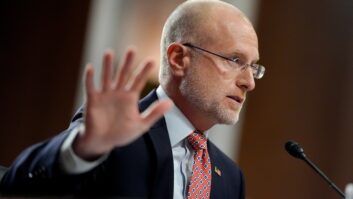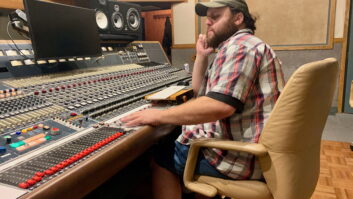Masked Engineer Guy Wire Recovers from a Cold DAB Shower
My colleague Skip Pizzi spends a lot of time gazing at the crystal ball of new technologies.
In his March 1 article in Radio World titled “FMX + RBDS = IBOC,” Skip is challenging and articulate.
For many in this industry, his analysis is disturbing. He may have succeeded in dousing the IBOC rollout later this year with a cold shower. But I think that this time, Skip’s crystal ball might have a few cracks.
Fuzzy Math
Can the fate of IBOC appropriately be extrapolated from failed “add-on” technologies like FMX and RBDS? These and virtually all proposed improvements since FM stereo have been nuances or targeted to niche users.
Include any of the others like FM Quad, AM stereo and AMAX. Neither the EIA/CEMA nor NAB, Detroit or the FCC really got behind any of them. Little coordinated effort was employed to get the major players on board to perfect the product, get it ready for market and roll it out to the public with an effective national advertising campaign.
The FCC never established mandated rules changes to compel adoption of these technologies as it did when the FM band had to be added to all radios and UHF channels had to be included in all TV sets.
Ibiquity is keenly aware of those kinds of crucial mistakes and is poised to prevent them from happening with IBOC. These same major players have been significantly invested in IBOC development and implementation for years.
IBOC is not a trivial add-on. It integrates a significant reduction in the annoying interference factors that separate radio from CDs in the overall listening experience. And it adds significant opportunities for digital data delivery never available with older technologies. It’s a different situation.
Really Skip, your equation is nothing more than fuzzy math.
History Lessons
Pizzi is convinced that the radio industry ignored the lessons of history and force-fed IBOC as a digital solution primarily to protect the ownership status quo. He says IBOC was a blocking policy from the beginning, without the benefit of “open standards development” that should have embraced new technologies, new bands and new players.
This might be the result of how too many years at NPR causes one to think more as a purist in an ideal world while ignoring how constraints already in place are integrated into a successful business model operating in a regulated free economy of the real world.
Look back to about 1989 at the beginnings of the digital radio revolution. An open standards development process did in fact drive digital conversion for a number of years. We had many proposals and studies done by the NAB along with consultants and entrepreneurs on how a digital radio system could be implemented in U.S. broadcasting.
Various new frequency band options were reviewed, including unused UHF TV channels, S Band and of course L Band. The new digital modulation schemes and bit-rate compression algorithms were considered carefully and tested by many interested parties.
I can recall Pizzi himself moderating a convention panel in the early 1990s that consisted of at least six digital systems proponents. Digital radio was anybody’s ballgame. They all took their best shot. But Eureka had a head start on us in Europe and quickly became the favorite.
The NAB was so convinced Eureka was the best solution, it tried to set up a for-profit Eureka licensing arm of itself and sell it to its own members. Not until it was clear that the Pentagon-driven federal government would not part with L Band or any other new frequencies in the United States to allow the Eureka system to gain support did the NAB back down.
We were all waiting and wondering back then if the NAB and FCC would be able to arm-wrestle the military out of new spectrum for digital broadcasting. But the memories of Operation Desert Storm were fresh. Our military held the ace cards and needed its spectrum to be able to deliver those future Patriot missiles with pinpoint accuracy.
Open Standards Struggle
After it was clear we’d be stuck with only the existing AM and FM bands for implementing digital, many of the larger group owners represented by the Radio Operators Caucus organized to support the development of an IBOC solution that would work. Project Acorn became USADR and eventually Ibiquity was born in part from that.
All incumbent broadcasters did not insist on IBOC from the beginning, as Skip would lead us to believe. The ones who were listening to their engineers mostly agreed that more bandwidth, only available in a new band, would be needed to properly deploy the advantages of digital broadcasting.
Even though it may not have lasted as long as we might have preferred, a de facto open standards process did launch us into digital and was functioning to some extent right up to the formation of Ibiquity only two years ago.
The question is, Skip, how long should we have waited for the military to change its mind about giving up a chunk of L Band or for technology advances to offer and perfect some other workable and marketable solution for the adoption of digital broadcasting in the United States? Perfect hindsight has revealed Eureka to be not the best solution here or anywhere else, at least so far.
Remember, even after it became clear IBOC would be the best overall solution for adding digital radio service in this country, USADR continued to joust with two competitors in the form of Lucent and Digital Radio Express. Each had a different design for the modulation scheme and different choice of compression algorithm. Compromise and negotiation resolved those differences as would happen in any open standards proceeding.
Consensus was alive and well in this phase of the process, Skip, and determined which elements of each proponent’s system would be part of the eventual proposal under the combined Ibiquity partnership.
Faith in America
Certainly the members of the operators’ caucus were interested in protecting their interests. They did what any property or business owner in the proud traditions of this country would do when a proposed new regulation threatened to dilute the value of their investments and their ability to survive and prosper. They ultimately had faith in American electronic ingenuity and its ability to design a system that would allow digital to coexist with analog in an IBOC solution.
The lessons of history guiding that effort were the previous successes of integrating color into existing black and white TVs and stereo into existing monophonic FM radios and TV sets. Backward compatibility allowing older receivers to still work with those inventions has served us well for many years.
Skip argues that, for digital radio to succeed, it must bring quantitative improvements to the public, i.e. more services. Qualitative improvements like higher fidelity and significant interference reduction won’t be enough.
The data capacity of IBOC FM will be increased dramatically over its analog uncle. Many of the new products, services and business models that will take advantage of that in the future haven’t even been invented. And don’t overlook the advantage that IBOC receivers will be “smart,” adapting to any coding changes from the transmitted end. Improvements will be implemented seamlessly, similar to how the new Windows Xp connected to the Internet updates itself automatically.
But let’s step back and appreciate what radio has been doing well since KDKA started broadcasting in 1920: delivering immediate information and entertainment to a listening public that is usually doing something else at the moment. Radio is about being able to listen to whatever you want, whatever you’re doing, anywhere, anytime and with minimal effort at the flick of a switch. And it’s free.
This is the strength of what radio always has been and probably always will be. You don’t need a screen to watch or lots of interactive features, user-definable options, or buttons to fumble with. I’m overloaded with those on my cell phone already, thank you. Why must we insist that the new digital radios need glitzy new “wow” options before the public will buy them?
The few real technical complaints we hear from radio listeners are based on interference problems. The IBOC improvements take that issue on. The vast majority of other complaints are almost always about programming content. Too many commercials, not enough variety, why is that idiot on the air and so forth.
Nobody is clamoring (or even asking nicely) for some new feature that radio was never expected nor intended to provide. RBDS has taught us something about that. Radio has a simple elegance all it’s own and doesn’t need clothes that don’t fit.
Charging for More Choices
Certainly satellite radio is providing more programming choices than will ever fit on local radio dials and will serve those who are willing to pay for them. If you happen to live where something you want is not available, you’ll have to pay for it to be delivered.
Satellite probably will become the best vehicle to provide more choices to those who live in sparsely populated areas where traditional choices are limited and local economies will not support adding more.
But for larger population centers, we already have almost 50 unique radio programming formats identified by the NAB, most of which are available somewhere on the AM or FM dial in those larger markets. Allow me to ask you, Skip: Which ones are we missing and how many more do we need? OK, I admit, we may have missed a few. The satellite services and LPFM should be able to provide whatever your imagination conjures up.
A successful broadcast radio station generally needs significant listener head-count and reasonably broad appeal to sustain its business model. Those that narrowcast with niche or boutique offerings to a tiny audience almost never survive very long unless they don’t depend on audience or advertising/underwriting support for their existence.
Creating more stations to provide more narrowcasted formats for small audiences is not the quantitative enhancement that digital radio should be bringing to the public, IMHO.
Wow Radios on the Way
While the improvements that IBOC radio brings are mostly qualitative, making it available in most new cars fairly early in the implementation cycle that Ibiquity has mapped out should assure its survival and success.
The “wow” radio that will be in demand soon will be the multimode digital car radio that offers integrated AM/FM/IBOC and satellite channels, CD/DVD, along with useful digital data services and display goodies.
As chip-set prices come down, cheaper IBOC tuners and desktop models for the home and office, as well as portable boom boxes and walkmans will be offered. They will sell based on the mere fact that they offer the new advanced digital reception, which listeners eventually will identify as better performing with higher quality from their car radio experience. It will be no different than with any other piece of consumer electronics equipment.
Witness what’s happening with DVD vs. VCR sales. As more titles come out on DVD and more stations broadcast in IBOC, the old gives way to the new. After IBOC rolls out, the Circuit City salesman only has to tell the prospective radio buyer that digital is newer and better, while analog is older and suffers from more interference. Analog in any electronic form really should be a dinosaur by then.
I will be the first to agree that the seven-second IBOC latency delay will perhaps at first introduce a confusing and disappointing complication for some listeners, especially sports fans.
But for the vast majority of the radio-consuming public, real-time audio is not necessary to be able to use and enjoy the content. The fact that the analog signal will be acquired instantly when changing channels satisfies the radio user’s historical expectations, and few will notice the seamless transition into digital a few seconds later.
The “digital delay penalty” will not be unique to radio. DTV faces the same challenge. The public will get used to it. They’re more adaptive and flexible than most give them credit for.
Drying Off Baby
As Skip points out, the FCC will be the final arbiter that ultimately will spell success or failure for IBOC.
But this is not AM Stereo Act 2. If the commission mandates that all stations deploy it by some future date, the public will be best served and not subjected to the confusion that doomed AM stereo.
If it does not mandate IBOC conversion, the situation might be a little bit more like FM stereo. Yes, it took a while for stations to install stereo encoders and for radios with little red stereo lights to appear; but even with its flaws, FM stereo became a de facto standard. This time around, more advanced technology and a smarter industry should pave the way for more rapid conversion and fewer negative side effects.
It’s a bit too late to throw the baby out with the bath water, Skip. Let’s just dry him off from your cold shower and keep moving ahead.







